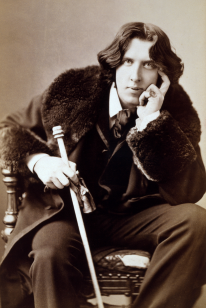What writers can learn from fashion.

The fashion world — like the art world, like the publishing world — no doubt has its slimy aspect. As with every commercial artform, success involves luck, pluck, connections, and, in fashion’s case, the seasonal pressure to reinvent the waistcoat, the pantleg, the heel. Oscar Wilde famously said, “A fashion is merely a form of ugliness so unbearable that we have to alter it every six months.”
Setting aside the notion of trends, fashion itself can be a lot of creative fun, an impetus to invent. Writers, whether they want to admit it or not, have been dabbling in such play since the dawn of the author photo. Close your eyes and spy Cormac McCarthy in his Western button-downs, Virginia Woolf in her pearls and occasional fur, Joan Didion with her coaster-size shades, Tom Wolfe’s snappy white suit, Colette’s coy menswear, and Toni Morrison’s business tie and voluminous grey hair.
During his 20s, Wilde himself began to cultivate the sleek, buttoned-up, velvet-jacket-wearing persona readily conjured in our mind’s eye, his hair bob-length, parted in the middle, and ever-so-slightly intentionally disheveled.
In his early 30s, needing money, Wilde served as editor of the Woman’s World, a Victorian fashion magazine made far more feministic and cutting edge on his watch, delivering readers “a wider range [of coverage], as well as a high standpoint” and dealing “not merely with what women wear, but with what they think, and what they feel” (Complete Letters). Articles on the aesthetics of dress, including crossdressing, became the norm. During his tenure, Wilde embraced and embodied his editor role just as he had his new grownup look.
Didion, herself a fashion icon — who posed for a Celine ad when well into her 80s — nailed concrete detail like nobody’s business. In her 1970 novel, Play It as It Lays, protagonist Maria considers wealthy Helene invincible in her silk blouse, her chunky emerald, her pricey hair color. In “Georgia O’Keeffe,” from the 1979 essay collection The White Album, Didion and her daughter, Quintana Roo, then 7, observe part of O’Keeffe’s vast abstract mural series “Sky Above Clouds” at the Chicago Art Institute. “I need to talk to her,” Didion quotes Quintana saying of O’Keeffe, continuing:
“Style is character. And I recall being pleased not only that my daughter responded to style as character but that it was Georgia O’Keeffe’s particular style to which she responded: this was a hard woman who had imposed her 192 square feet of clouds on Chicago.”
I like the connections Didion makes here. If style is character, the reverse is also true. And fashion becomes a powerful way to express selfhood in all its variety. “You can have anything you want in life if you dress for it,” legendary costume designer Edith Head famously said.
Perhaps that advice holds true on the level of literary imagination. I believe that creative writers can learn a lot about themselves — their multiple inner selves — and their characters’ diverse interior lives by putting some imagination into getting dressed each day.
In one of my early short stories, “Scarecrow,” tween narrator Sarah Jane is mocked at school because she wears ill-fitting dresses from Goodwill. However, she sees her wardrobe as antique treasure, her dresses as gowns befitting queens. When a friend of the family gifts Sarah Jane’s overweight mother brand-new jeans — in a size too large — from a Texas department store, her mom is insulted by both the pity and the presumption. The jeans go unworn. The character is illuminated.
I, too, love to shop at Goodwill. I go every week and treat myself to anything that strikes my fancy. Not long ago, I found a bright red Calvin Klein dress (tags still on). It became my royal gown for a reading event that week. Thanks to Goodwill, I own roughly 25 pairs of designer jeans for the cost of one new pair; my “Real Housewives”-esque jean bar is a decadent addition to my oversized closet.
Via fashion, I can play out my daydreams and fantasies and thus lovingly groom my evolving self. I can also experience how others live (those with jean bars, for instance). By stepping inside this game of dress-up, I not only create temporary selves, I create new fictional characters with better specificity, ease, and believability.
When was the last time you took your selves shopping?
[Editor’s note: Betsy Boyd guest wrote this month’s “Nerd Volta” at the invitation of columnist Steven Leyva.]
Betsy Boyd directs the Creative Writing and Publishing Arts MFA program at the University of Baltimore and is the recipient of two Maryland State Arts Council awards, an Elliot Coleman Writing Fellowship, a James A. Michener Fellowship, and residencies through Fundación Valparaíso, the Virginia Center for the Creative Arts, the Alfred and Trafford Klots International Program for Artists, and the Kimmel Harding Nelson Center for the Arts. Her fiction has been published in Kenyon Review, StoryQuarterly, Shenandoah, and at American Short Fiction, Eclectica, and elsewhere. Her short story “Scarecrow” received a Pushcart Prize, and “A Random Strike” is a Wigleaf top 50 for 2023.

